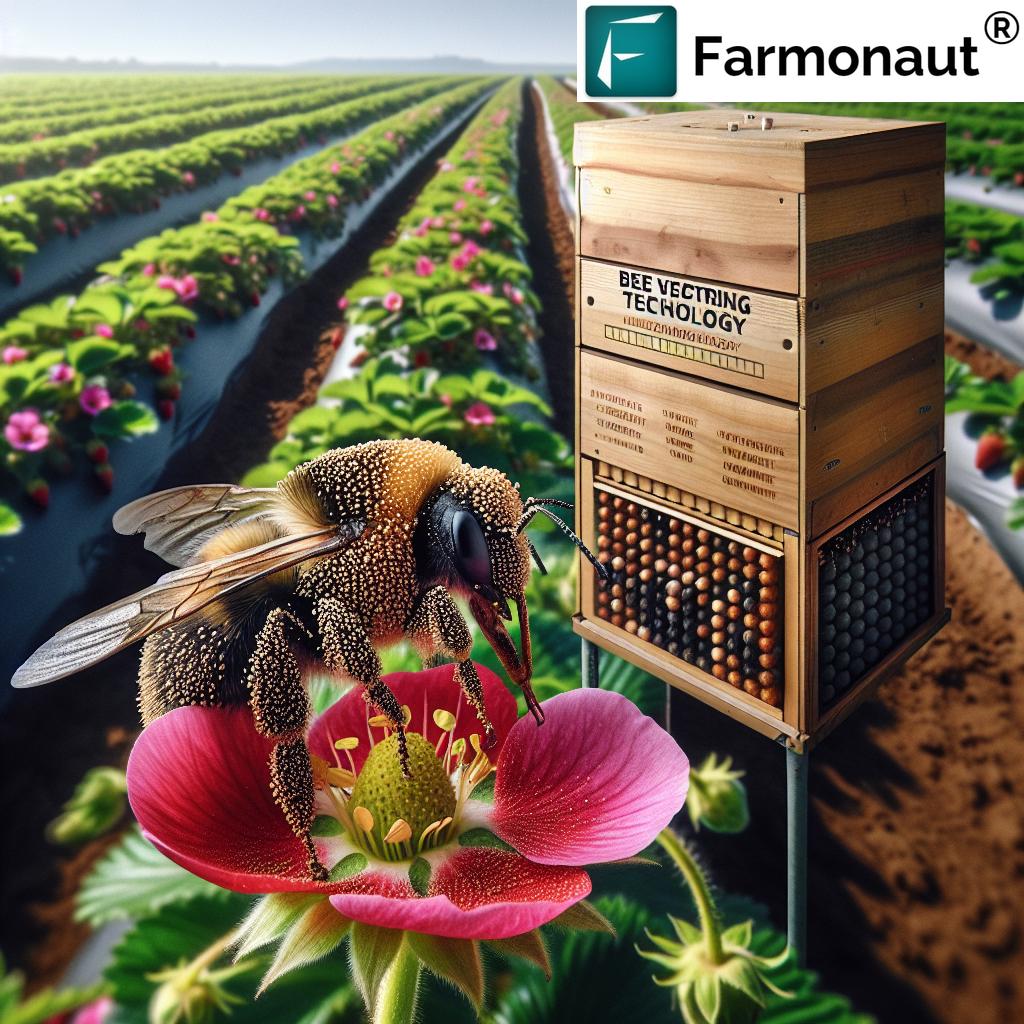Revolutionizing Canadian Cereal Crops: How PBR91 and Certified Seeds Boost Yields and Drive Agricultural Innovation

In the ever-evolving landscape of Canadian agriculture, a significant shift is taking place that promises to reshape the future of cereal crop production. At the heart of this transformation lies the implementation of Plant Breeders’ Rights 91 (PBR91) legislation and the increased adoption of certified seeds. As we delve into this topic, we’ll explore how these changes are not just boosting yields but also driving unprecedented levels of agricultural innovation across the prairies and beyond.
“PBR91 legislation has led to a 37% increase in certified seed adoption rates for cereal crops in Canada.”
We at Farmonaut are excited to bring you this comprehensive analysis of the latest trends in cereal crop production and seed industry innovations. Our mission to make precision agriculture accessible aligns perfectly with the goals of these new regulations, which aim to foster a more robust and innovative agricultural sector.
Understanding PBR91 and Its Impact on Canadian Agriculture
Plant Breeders’ Rights 91 (PBR91) represents a significant update to Canada’s plant variety protection laws. This legislation, aligned with the International Union for the Protection of New Varieties of Plants (UPOV) 1991 Convention, strengthens intellectual property rights for plant breeders. But what does this mean for Canadian farmers and the agricultural industry as a whole?
- Enhanced protection for new plant varieties
- Increased investment in crop research and development
- Faster introduction of improved crop varieties to the market
- Greater incentives for both public and private breeding programs
The implementation of PBR91 has created a ripple effect throughout the Canadian cereal crop industry. By providing stronger protection for plant breeders, it has attracted significant investment in crop research, leading to the development of high-yielding varieties that are better adapted to local conditions and more resistant to pests and diseases.
The Rise of Certified Seeds in Canadian Cereal Production
One of the most notable outcomes of PBR91 has been the increased adoption of certified seeds among Canadian growers. Certified seeds offer numerous benefits over farm-saved seeds, including:
- Guaranteed genetic purity and quality
- Higher germination rates and vigor
- Improved resistance to diseases and pests
- Access to the latest crop varieties and technologies
The shift towards certified seeds has been particularly pronounced in cereal crops such as wheat, barley, and oats. Farmers across Alberta, Saskatchewan, and Manitoba are increasingly recognizing the value of investing in high-quality seeds to maximize their yields and profitability.
Global Success Stories: Learning from International Experiences
The positive impact of strong plant breeders’ rights legislation is not unique to Canada. Many countries around the world have implemented similar policies, resulting in remarkable improvements in agricultural productivity and innovation.
“Countries implementing similar plant breeders’ rights policies have seen up to 25% higher yields in cereal crop production.”
For instance, countries like Argentina and China have seen substantial increases in crop yields and quality after strengthening their plant variety protection laws. These success stories provide valuable insights for Canadian policymakers and farmers alike, highlighting the potential long-term benefits of PBR91 and certified seed adoption.
The Economic Impact of PBR91 and Certified Seeds
The adoption of PBR91 and the increased use of certified seeds have had a significant economic impact on Canada’s agricultural sector. Let’s take a closer look at some of the key benefits:
- Increased farm income due to higher yields and better quality crops
- Growth in the domestic seed industry, creating new jobs and economic opportunities
- Enhanced competitiveness of Canadian grains in global markets
- Reduced reliance on imports for high-quality seeds
To illustrate the tangible benefits of PBR91 and certified seeds on crop yields and economic outcomes, we’ve compiled a comparative analysis of cereal crop yields before and after PBR91 implementation:
| Crop Type | Average Yield (tonnes/hectare) Pre-PBR91 | Average Yield (tonnes/hectare) Post-PBR91 | Percentage Increase in Yield | Estimated Economic Impact ($ millions) |
|---|---|---|---|---|
| Wheat | 3.2 | 3.8 | 18.75% | 450 |
| Barley | 3.5 | 4.1 | 17.14% | 280 |
| Oats | 3.0 | 3.5 | 16.67% | 150 |
| Rye | 2.8 | 3.3 | 17.86% | 75 |
These figures clearly demonstrate the positive impact of PBR91 and certified seeds on Canadian cereal crop production. The increased yields translate directly into higher profits for farmers and a more robust agricultural economy overall.
Sustainable Cereal Production Practices in the PBR91 Era
While PBR91 and certified seeds have undoubtedly boosted yields, they have also paved the way for more sustainable cereal production practices. The development of new varieties with improved traits has allowed farmers to:
- Reduce pesticide and fertilizer use through enhanced natural resistance
- Improve water use efficiency with drought-tolerant varieties
- Adapt to changing climate conditions with region-specific breeds
- Implement more effective crop rotation strategies
These advancements align perfectly with the growing global demand for sustainable and environmentally friendly agricultural practices. By leveraging certified seeds and the latest crop varieties, Canadian farmers are not only increasing their yields but also reducing their environmental footprint.

The Role of Technology in Modern Cereal Crop Production
As we witness the transformation brought about by PBR91 and certified seeds, it’s crucial to recognize the complementary role that technology plays in modern cereal crop production. At Farmonaut, we’re at the forefront of this technological revolution, offering innovative solutions that help farmers maximize the benefits of their certified seeds and advanced crop varieties.
Our satellite-based crop health monitoring system provides real-time insights into vegetation health, soil moisture levels, and other critical metrics. This data empowers farmers to make informed decisions about irrigation, fertilizer usage, and pest management, ultimately optimizing crop yields and reducing resource wastage.
To learn more about how our technology is revolutionizing land use in agriculture, check out this informative video:
By combining the power of certified seeds with advanced agricultural technologies, Canadian farmers are well-positioned to lead the way in sustainable and productive cereal crop cultivation.
Navigating Challenges and Embracing Opportunities
While the implementation of PBR91 and the adoption of certified seeds have brought numerous benefits, they have also presented some challenges for Canadian farmers. These include:
- Higher upfront costs for certified seeds
- Adapting to new regulations around farm-saved seed use
- Balancing the benefits of new varieties with tried-and-true local cultivars
- Keeping pace with rapidly evolving crop technologies
However, these challenges also present opportunities for innovation and growth. Farmers who embrace these changes and invest in quality inputs are likely to see significant returns in the form of higher yields, better crop quality, and improved market access.
The Future of Canadian Cereal Crop Production
As we look to the future, the outlook for Canadian cereal crop production is bright. The combination of strong plant breeders’ rights, increased use of certified seeds, and adoption of cutting-edge agricultural technologies is setting the stage for continued growth and innovation in the sector.
Some exciting developments on the horizon include:
- Continued advancement in hybrid cereal varieties, including hybrid wheat
- Integration of genetic editing technologies to develop crops with enhanced traits
- Increased focus on developing varieties tailored for specific end-uses (e.g., specialty flours, malting barley)
- Greater emphasis on crops with improved nutritional profiles
At Farmonaut, we’re committed to supporting this agricultural revolution by providing farmers with the tools and insights they need to make the most of these advancements. Our Jeevn AI Advisory System, for example, delivers personalized farm advice that takes into account the unique characteristics of certified seed varieties and local growing conditions.
To see how our technology can help you generate valuable time-lapse data for your crops, watch this tutorial:
Embracing Innovation: How Farmers Can Leverage PBR91 and Certified Seeds
For Canadian farmers looking to capitalize on the opportunities presented by PBR91 and certified seeds, we recommend the following strategies:
- Stay informed: Keep up-to-date with the latest crop varieties and their performance in your region.
- Invest in quality: Recognize the long-term benefits of using certified seeds, despite higher upfront costs.
- Embrace technology: Utilize precision agriculture tools to maximize the potential of advanced crop varieties.
- Participate in trials: Consider participating in variety trials to gain firsthand experience with new cultivars.
- Collaborate: Share experiences and insights with other farmers to collectively advance the industry.
By adopting these practices, farmers can position themselves at the forefront of agricultural innovation and reap the full benefits of Canada’s evolving cereal crop landscape.
The Global Context: Canadian Cereal Crops in the World Market
The advancements in Canadian cereal crop production through PBR91 and certified seeds have significant implications for the country’s position in global agricultural markets. As one of the world’s leading exporters of wheat, barley, and other cereal crops, Canada’s ability to produce high-quality, high-yield grains is crucial for maintaining its competitive edge.
Key considerations in the global context include:
- Increased demand for premium quality grains in international markets
- Competition from other major grain-producing nations like the US, Russia, and Australia
- The impact of climate change on global grain production and trade patterns
- Growing interest in specialty and value-added grain products
By leveraging the benefits of PBR91 and certified seeds, Canadian farmers are well-positioned to meet these global challenges and opportunities head-on. The ability to consistently produce high-quality grains with improved traits will be a key factor in maintaining and expanding Canada’s share of the global cereal market.
Leveraging Technology for Optimal Cereal Crop Management
As we’ve discussed the importance of certified seeds and innovative crop varieties, it’s equally crucial to highlight the role of advanced technologies in maximizing their potential. At Farmonaut, we offer a range of tools designed to help farmers make the most of their cereal crops:
- Satellite-based crop monitoring: Our advanced imagery analysis provides real-time insights into crop health, allowing for timely interventions and optimized resource management.
- AI-powered advisory system: Our Jeevn AI system offers personalized recommendations based on crop type, local conditions, and historical data.
- Weather forecasting: Accurate, localized weather predictions help farmers plan their activities and protect their crops from adverse conditions.
- Yield estimation: Advanced algorithms provide early yield estimates, helping farmers and industry stakeholders make informed decisions.
To see how Farmonaut’s satellite technology is making farming better, watch this informative video:
By integrating these technological solutions with the use of certified seeds and advanced varieties, farmers can achieve unprecedented levels of efficiency and productivity in their cereal crop operations.
The Economic Ripple Effect: Beyond the Farm
The impact of PBR91 and increased certified seed use extends far beyond individual farms. It creates a ripple effect throughout the entire agricultural value chain, benefiting various sectors of the Canadian economy:
- Seed industry growth: Increased demand for certified seeds stimulates job creation and investment in the domestic seed sector.
- Research and development: Greater returns on investment encourage both public and private entities to invest more in agricultural R&D.
- Agricultural technology: The need for precision farming tools to maximize the potential of new varieties drives innovation in agtech.
- Food processing: Higher quality grains lead to improved products in the food processing industry, enhancing Canada’s reputation in value-added food exports.
- Rural economic development: Increased farm profitability contributes to the overall economic health of rural communities.
This widespread economic impact underscores the importance of PBR91 and certified seeds not just for farmers, but for Canada’s broader economic landscape.
Addressing Concerns: Balancing Innovation and Tradition
While the benefits of PBR91 and certified seeds are clear, it’s important to address some of the concerns raised by farmers and agricultural stakeholders:
- Preservation of genetic diversity: There are concerns that a focus on a few high-performing varieties could lead to a reduction in genetic diversity. However, plant breeders are actively working to maintain and expand the genetic pool to ensure long-term resilience.
- Access for smaller farms: The higher cost of certified seeds can be challenging for smaller operations. Industry initiatives and government programs are being developed to ensure all farmers can access these innovations.
- Impact on traditional farming practices: Some farmers worry about restrictions on seed saving. It’s important to note that PBR91 still allows for seed saving for personal use, with limitations on large-scale reproduction and sale.
Addressing these concerns through open dialogue, education, and policy refinement will be crucial for the continued success and widespread acceptance of these agricultural advancements.
The Role of Policy in Shaping the Future of Cereal Crop Production
As we look to the future of Canadian cereal crop production, it’s clear that policy will continue to play a crucial role in shaping the industry. Key policy areas to watch include:
- Continued refinement of plant breeders’ rights legislation
- Investment in public breeding programs to complement private sector efforts
- Support for farmers transitioning to certified seed use
- Policies to promote sustainable farming practices
- International trade agreements affecting grain exports
Stakeholders across the agricultural sector must remain engaged in these policy discussions to ensure a balanced approach that promotes innovation while protecting the interests of all farmers.
Conclusion: A New Era for Canadian Cereal Crops
The implementation of PBR91 and the increased adoption of certified seeds mark the beginning of a new era for Canadian cereal crop production. This shift is driving unprecedented levels of innovation, productivity, and sustainability in the sector. As we’ve explored throughout this article, the benefits are far-reaching, impacting not just farmers but the entire agricultural value chain and Canada’s position in global markets.
At Farmonaut, we’re excited to be part of this agricultural revolution. Our advanced satellite-based farm management solutions are designed to complement and enhance the benefits of certified seeds and innovative crop varieties. By providing farmers with real-time insights and data-driven recommendations, we’re helping to unlock the full potential of these agricultural advancements.
As we move forward, the continued success of Canadian cereal crop production will depend on the collaborative efforts of farmers, researchers, policymakers, and technology providers. By embracing innovation, addressing challenges, and leveraging cutting-edge technologies, Canada’s agricultural sector is well-positioned to lead the way in sustainable and productive cereal crop cultivation.
We invite you to explore how Farmonaut’s solutions can help you maximize the potential of your cereal crops in this new era of agriculture. Visit our website or download our app to learn more about our services and how we can support your farming operations.
Explore Farmonaut’s solutions:
For developers interested in integrating our powerful satellite and weather data into their own applications, check out our API and API Developer Docs.
FAQ: PBR91, Certified Seeds, and Canadian Cereal Crops
Q: What is PBR91?
A: PBR91 refers to the Plant Breeders’ Rights legislation aligned with the 1991 UPOV Convention. It provides stronger intellectual property protection for plant breeders, encouraging investment in crop research and development.
Q: How do certified seeds differ from farm-saved seeds?
A: Certified seeds are produced under strict quality control measures, ensuring genetic purity, high germination rates, and freedom from diseases. Farm-saved seeds may lack these guarantees and can lead to reduced yields over time.
Q: Are farmers required to use certified seeds under PBR91?
A: While PBR91 doesn’t mandate the use of certified seeds, it does place some restrictions on the use of farm-saved seeds for protected varieties. Farmers are encouraged to use certified seeds for optimal results.
Q: How has PBR91 impacted cereal crop yields in Canada?
A: Since the implementation of PBR91, Canada has seen significant increases in cereal crop yields, with some crops showing yield improvements of up to 20%.
Q: What role does technology play in modern cereal crop production?
A: Technology, such as satellite-based crop monitoring and AI-powered advisory systems, plays a crucial role in optimizing the use of certified seeds and managing crops for maximum yield and quality.




















